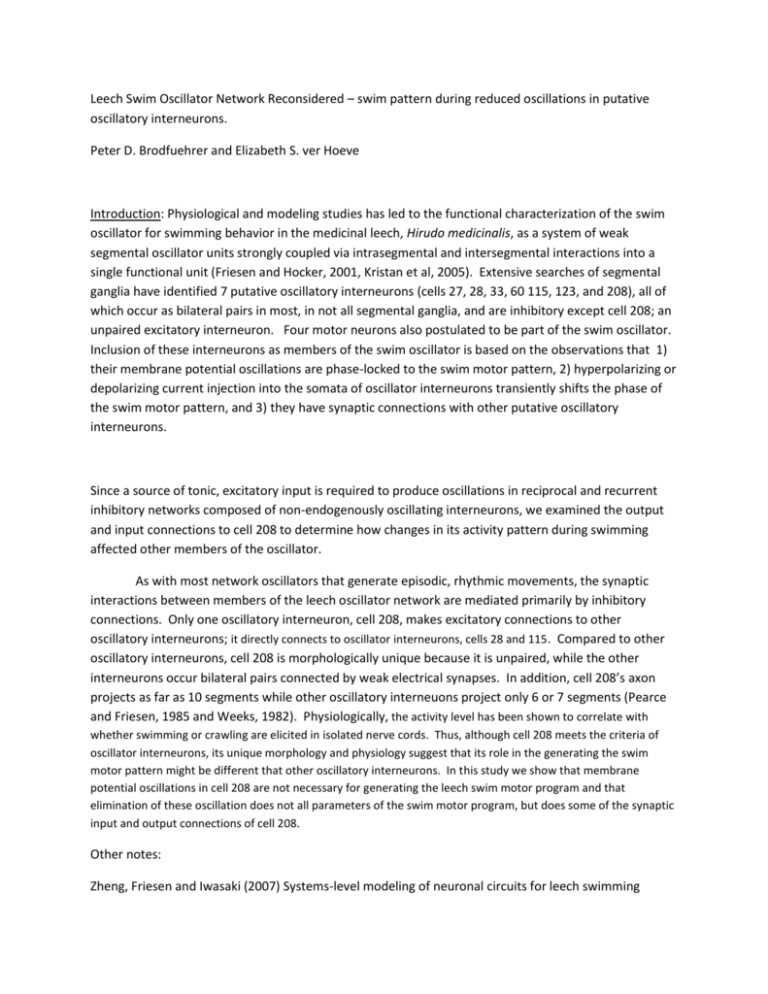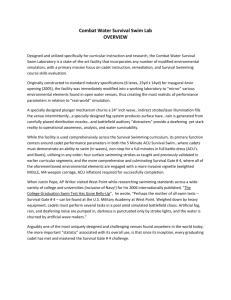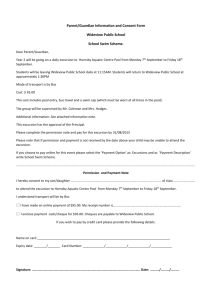Swim Oscillator Network Reconsidered120810
advertisement

Leech Swim Oscillator Network Reconsidered – swim pattern during reduced oscillations in putative oscillatory interneurons. Peter D. Brodfuehrer and Elizabeth S. ver Hoeve Introduction: Physiological and modeling studies has led to the functional characterization of the swim oscillator for swimming behavior in the medicinal leech, Hirudo medicinalis, as a system of weak segmental oscillator units strongly coupled via intrasegmental and intersegmental interactions into a single functional unit (Friesen and Hocker, 2001, Kristan et al, 2005). Extensive searches of segmental ganglia have identified 7 putative oscillatory interneurons (cells 27, 28, 33, 60 115, 123, and 208), all of which occur as bilateral pairs in most, in not all segmental ganglia, and are inhibitory except cell 208; an unpaired excitatory interneuron. Four motor neurons also postulated to be part of the swim oscillator. Inclusion of these interneurons as members of the swim oscillator is based on the observations that 1) their membrane potential oscillations are phase-locked to the swim motor pattern, 2) hyperpolarizing or depolarizing current injection into the somata of oscillator interneurons transiently shifts the phase of the swim motor pattern, and 3) they have synaptic connections with other putative oscillatory interneurons. Since a source of tonic, excitatory input is required to produce oscillations in reciprocal and recurrent inhibitory networks composed of non-endogenously oscillating interneurons, we examined the output and input connections to cell 208 to determine how changes in its activity pattern during swimming affected other members of the oscillator. As with most network oscillators that generate episodic, rhythmic movements, the synaptic interactions between members of the leech oscillator network are mediated primarily by inhibitory connections. Only one oscillatory interneuron, cell 208, makes excitatory connections to other oscillatory interneurons; it directly connects to oscillator interneurons, cells 28 and 115. Compared to other oscillatory interneurons, cell 208 is morphologically unique because it is unpaired, while the other interneurons occur bilateral pairs connected by weak electrical synapses. In addition, cell 208’s axon projects as far as 10 segments while other oscillatory interneuons project only 6 or 7 segments (Pearce and Friesen, 1985 and Weeks, 1982). Physiologically, the activity level has been shown to correlate with whether swimming or crawling are elicited in isolated nerve cords. Thus, although cell 208 meets the criteria of oscillator interneurons, its unique morphology and physiology suggest that its role in the generating the swim motor pattern might be different that other oscillatory interneurons. In this study we show that membrane potential oscillations in cell 208 are not necessary for generating the leech swim motor program and that elimination of these oscillation does not all parameters of the swim motor program, but does some of the synaptic input and output connections of cell 208. Other notes: Zheng, Friesen and Iwasaki (2007) Systems-level modeling of neuronal circuits for leech swimming Intersegmental coupling strength turned out to be positively correlated with the oscillation amplitude. Methods: Results: Cell 208 activity and swim motor program. During a swim bout, the membrane potential of cell 208 is depolarized from its resting level and undergoes large membrane potential oscillations (8 – 15 mV) interspersed with rhythmic bursts of impulses that are approximately in phase with dorsal motor neuron bursts of impulses in its own ganglion (Fig. 1A, Weeks, 1982). Bath application of 10-4 M curare significantly reduced the hyperpolarizing phase of cell 208’s membrane potential oscillations, effectively eliminating one of the criteria for characterizing an interneuron as a member of the oscillator (i.e., that an oscillator interneurons’s membrane potential oscillates in-phase with the swimming rhythm). Instead of oscillating, cell 208 often appeared almost tonically active during swimming similar to the activity profile of cell 204 during swimming (Figs. 1B and 2). To quantify the change in the membrane oscillations of cell 208 in response to curare, the peak-topeak amplitude of the membrane potential oscillations was measured between the 3rd and 4th swim cycle in normal saline and in curare. As can be seen in Fig. ?, the peak-to-peak amplitude of the oscillations in cell 208 decreased by approximately 64% after 4-5 min in curare. The maximum level of depolarization and firing frequency of cell 208 during the depolarized phase of its oscillations did not change in curare compared to normal saline (need to get these measurements). Closer examination of 208’s activity in normal saline and curare revealed that in curare, the timeframe when the membrane potential of cell 208 would be hyperpolarized and not spiking gradually disappeared. After sustained expose to curare only a slight oscillation is observed in 208’s membrane potential, with the spikes occurring throughout its normal hyperpolarizing phase (Figs. 2B, 5 & 6). The longer preparations were exposed to curare the greater its effect on the activity pattern of cell 208. The change in cell 208’s activity pattern is not a result of a change in resting membrane potential (Fig. 3)or membrane resistance (Fig?). The effect of curare on cell 208 was reversible after approximately 10 - 15 minute wash in normal saline (Fig. 1). Curare’s effect on cell 208 was observed in every preparation in which cell 208 was monitored intracellularly (n=> 15), and these effects were seen in cell 208 in all segmental ganglia examined - 4, 10, 11, 12, and 13. To assess the effect that curare had on the overall swim motor program, we compared parameters of the swim motor program as measured in DP bursts from two ganglia in isolated nerve cords in normal saline, curare and after washout. We found no significant differences were observed in the average swim period, number of spikes per burst, burst duration, number of bursts per episode or segmental phase relationship (one-way ANOVA, P>0.05, Fig. 2) between the three conditions, although there was a trend for bursts per episode to decrease slightly in curare compared to normal saline and washout. Input and output connections of cell 208. Cell 208 receives direct synaptic input from two interneurons associated with generating swimming: cell 204, a swim-gating interneuron, excites cell 208, while cell 60, an oscillator interneuron, inhibits it. Bath application of curare had no effect on cell 204 during swim bouts. As is shown in Fig ?, the amplitude of the sustained depolarization of cell 204 during swimming did not change in curare even though the amplitude of the inhibitory phase of the oscillations in cell 208 decreased (n=3, check). In curare, stimulation of cell 204 still excited cell 208 (not shown). Oscillations in cell 60 were also not affected by curare (increased of 2.2% + 2.9%; n=2; Fig. ?). However, the inhibitory connection from cell 60 to cell 208 was eliminated in curare (Fig ?), although the rectifying electrical junction was still evident. Surprisingly, the inhibitory phase of oscillations in cell 208 often returned, though not at pre-curare levels, prior to the return of the inhibitory connection from cell 60 to cell 208. Cell 208 also directly excites two other oscillator interneurons, cell 28 and 115. We found that on average, within 4 to 5 minutes after bath application of curare, the amplitude of cell 208’s oscillations decreased by 63.5%+3.6% (n=7), the amplitude of oscillations in cell 115 and 28 decreased by 24.9% + 14.0% (n =3) and 19.1% + 17.3% (n=2), respectively (Fig 4). The time course with which the oscillations in cell 28 (Fig. 5) and 115 (Fig. 6) paralleled the time course of changes in cell 208. In addition, the shape of the oscillations in cell 208, 115, and 28, and the phase relationship between the cell pairs changed in curare compared to normal saline. For example, the duration of the depolarizing phase of 28’s membrane oscillations increased and the hyperpolarizing phase decreased in curare compared to normal saline (Fig. 5). In normal saline, the hyperpolarizing phase of the oscillations in cell 208 slightly preceded the hyperpolarizing phase in cell 115; however, in curare, cell 115 hyperpolarizing oscillations preceded or are in phase with those in cell 208. To a large degree, the amplitude, shape and phase relationship of the oscillations return following 10 minutes of wash out with normal saline. Curare did not block the excitatory connections from 208 to 115 and 28, or to cell 3, a motor neuron to the dorsal longitudinal muscles involved in producing the swimming movements in each segment (Fig. ?). Role of cell 208. Five functional classes of interneurons have been described in the leech swim generating network – sensory, gating, oscillatory, motor and modulatory. Cell 208 was classified as an oscillator interneuron because 1) its membrane potential oscillates in phase with swimming rhythm, 2) it connects directly to other oscillator interneurons and swim motor neurons, and 3) brief depolarization of cell 208 can reset the swimming rhythm. The findings in this study strongly suggest that cell 208 may be misclassified since elimination of its membrane oscillations; specifically, the hyperpolarizing phase, does not disrupt the swimming rhythm. In fact, the activity pattern of cell 208 during swimming in curare more closely resembles the activity pattern of swim-gating interneuron, cell 204. Swim gating interneurons are neurons whose activity is required for maintaining the swimming rhythm. To test if cell 208 can act as a gating interneuron for swimming, cell 208 was continuously depolarized for various durations to determine if there was a correlation between the duration of 208 depolarization and the number of bursts per swim episode in both normal saline and curare. In one experiment, no correlation between number of bursts per episode and duration of cell 208 depolarization in normal saline and curare was found (Fig. 8). In addition, depolarization of cell 208 in a quiescent preparation (not swimming) did not initiate swimming, which is a property of swim-gating interneuron cell 204 (not shown). Fig.1 change in 208 oscillitions Fig 2 no change in swim motor program (slight decrease in # of BPE) Analysis of its effect on other neurons in circuit that interact with 208 204,115, 60, 28 and 3 Do we mention non-nMDA affects on oscillations? Stops swimming, decreases oscillations in 208 but does not eliminate them.








